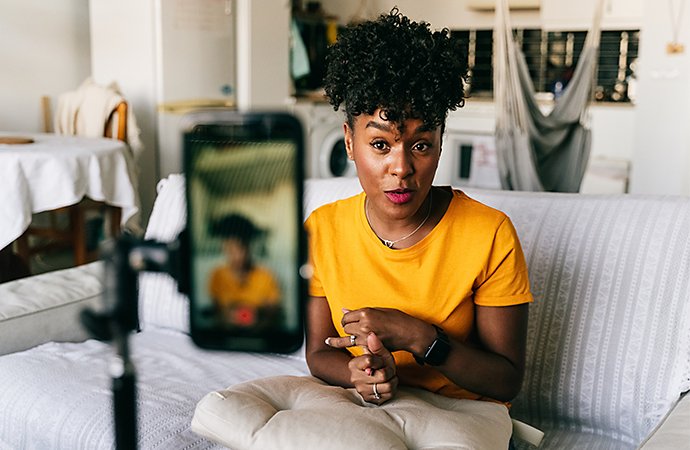Make medical videos that help explain healthcare.
Whether it’s a discussion of orthopedics or a talk on the highlights of hematology, learn how to make medical videos that connect with both the public and medical students.
What is a medical video?
Medical videos are any videos about healthcare, medicine, or what it’s like to be a medical professional. They cover content like a nurse vlogging about a normal day working in an emergency medicine department or a doctor giving an in-depth lecture on cardiology neurology.
Medical videos can also be valuable resources for people interested in the healthcare field, like potential nursing or medical students who want to know what it’s like to go to medical school or work in a clinic. Videos can also be a great study aid for medical education students who want to absorb information in as many ways as possible.
Make your medical videos informative.
Before you begin your video project, determine who your audience is. Are your viewers ordinary people or do they have medical training?
Medical videos for the general public.
Medical videos for a lay audience need to be accessible and understandable. They are often done in the style of explainer videos.
“A lot of it has to do with educating the general public, our patient population,” says nurse and YouTuber Sarah Flanagan. “It’s about simplifying medical terminology and important topics surrounding public health.”

The public wants to know how certain things affect them and their health. That means walking them through topics from a patient’s-eye perspective. Viewers will likely want to know things like:
- Answers to healthcare questions: What are the warning signs of heart failure? What causes stomach pains?
- What to expect from the healthcare system: What is a physical exam like? What does a typical hospital visit entail?
- Healthcare tips: What are ways to stay healthy? What are healthy eating habits? What are ways to avoid infectious diseases?
Medical videos for the public also need to be ready to do some myth-busting. The internet is filled with medical disinformation. Good medical videos can help push back on anti-vaccine conspiracy theories, outdated medical information, or misinformation on major topics like COVID-19.
“When you have a platform, you want to do your best to spread accurate information,” says Flanagan. “I help educate people and dispel misinformation, providing my knowledge and amplifying the knowledge of professionals who have more expertise than I do.”
Regardless of your subject matter, make it clear that what you say is not explicit medical advice. If patients need that, they need to check with their healthcare provider. While you can provide some insight, advise people watching your videos that they are no substitute for talking to an expert.
Medical videos for healthcare students and professionals.
Videos for clinicians or students are less common but still a valuable resource. Often, schools and healthcare companies hire companies to make these aids.
When you’re speaking to your fellow healthcare providers, you can assume a certain level of knowledge of academic and technical terms. However, you still need to be clear, concise, and easy to understand. This is important even if you’re speaking to an audience of peers or colleagues instead of speaking as someone with outside expertise.
As with education videos, viewers might not yet have a full understanding of the subject matter — even experts need refreshers on things outside their specific area of expertise. Keep your own level of expertise in mind. Even if you know one field well, there’s always more to learn, and new information and best practices emerge all the time.
Reach out to experts while making your videos. If you’re doing a video on dermatology, contact a dermatologist. If you want to make videos about children’s health, find an expert in pediatrics who’s willing to talk to you. If you have a platform, you can use it to connect experts to a larger audience, which can be very powerful.
Day-to-day as a medical video creator.
How to prepare for medical videos.
Planning is key to success with any YouTube video or instructional film, and the same goes for medical videos. While it’s important to keep a conversational tone, you’ll want to work from a script or outline. Don’t try to wing it in front of the camera. Be sincere, but work from prepared material. Even so, be prepared to edit. Flanagan shoots about an hour of material for every ten minutes that actually make it online.
Let your voice come through. Medical topics can be daunting, complicated, and technical. Giving a personal account of what it means to study at a school of medicine or work in a challenging field like immunology can be invaluable for upcoming professionals.
A relatable human tone is also helpful for the general public too. People outside the medical profession can often feel vulnerable and overwhelmed when they’re in a healthcare setting. Telling them what to expect and what everything means in your own voice can be a big help.


Equipment for medical videos.
Most videos can be shot on a smartphone, but as you progress with medical videos, you may want to upgrade. “If you’re investing in a camera, definitely get a good sturdy tripod,” says Flanagan. “You want a good one, because you’re going to bang it around a lot.”
Even with a good camera setup, vertical smartphone videos can be perfect for platforms like TikTok and Instagram. Your video library on YouTube or Vimeo might be the core of your brand, but shorter work for social media can reach a larger audience. Adobe Premiere Pro has tools that can help you easily convert horizontal videos to a vertical aspect ratio.
How to thrive as a medical video creator.
Successful content creators promote themselves on all channels and identify influencers and experts within their fields. Build relationships with doctors, nurses, institutions, and other various members of interdisciplinary teams that make up healthcare. Look for knowledgeable people to talk to, and consider doing interviews with them as a way to reach their audience as well as yours. These relationships can potentially lead to making more involved content, partnering with other professionals on projects, or creating videos on behalf of institutions.
Keep a schedule, release regular content, and engage with your audience. Don’t expect instant success, but if you keep at it and build a video library, you’ll find your audience, and they’ll find you too.
Contributor
Do more with Adobe Premiere Pro.
Make visually stunning videos virtually anywhere — for film, TV and web.
You might also be interested in…
How to start a YouTube channel.
Stand out from the crowd and find success for your videos with these tips.
How to create a YouTube video.
Make better videos by learning best practices from professional videographers and content creators.
An introduction to whiteboard animation.
Learn how to make high-quality whiteboard animation videos and develop your own style.
Get Adobe Premiere Pro
Create flawless productions with the industry-leading video editing software.
7 days free, then €26.86/mo.



